Whilst the Star Trek franchise is generally as mainstream as sci-fi gets, what most passing viewers tend to think of is either the groundbreaking Original Series with Shatner and Nimoy or the hugely successful Star Trek: The Next Generation.
The other three Star Trek series’ tend to be largely overlooked by all except proper fans; the last of these, Enterprise (with Quantum Leap’s Scott Bakula as the lead) suffered a massive drop in interest and following, while Voyager, though it had its occasional moments, was generally not of the standard of its predecessors.
However, the third series in the franchise, ‘Star Trek: Deep Space Nine‘ (1993 – 1999) is in my opinion one of the most underrated and under-appreciated television series’ in history and in fact the very best Star Trek series to date.
It’s a series that is difficult to explain to someone who hasn’t seen any of it (like trying to explain the film Inception to a not-very-fluent-in-English grandmother); but that is partly a pointer to its strengths. Whereas most television shows, and certainly all of the other Trek series’ can be explained in one sentence – “they’re on a ship exploring the galaxy and every week they have a new adventure and then move on…” – ST:DS9 is so complex and multifaceted an entity that it’s virtually impossible to sum up in a snappy sentence.
Part of that is in its structure; unlike the other Star Trek series’, which are broadly episodic, DS9, especially in its later seasons, was much more like a continuous serialisation (more like ‘Babylon 5‘, to which it was often compared); a collection of ongoing storylines and interconnecting threads.
This multi-faceted form meant that by the final season there were so many storylines and character arcs to be resolved that the writers had to set up a 9-episode finale just to do it justice.
Even the ninety-minute series finale itself – the epic What You Leave Behind – had so much going on that it was almost impossible to write; so many plots to resolve, so many characters to say goodbye to and relationships to tie up, including the fate of entire societies and worlds. This was a testament to just how rich a fictional tapestry Ira Steven Behr and co had woven in their several years of screen time.
I cannot stress how much DS9 has been a part of my cultural landscape and how much the series meant to me both at the time of its broadcast and beyond.
I was about 17 when I first started watching DS9; I actually didn’t even properly become a loyal viewer until the beginning of the fourth season, the first three years of the show being a largely hit-or-miss affair. But once I crossed that threshold there was no going back. I had been a fan, of course, of The Next Generation, to which DS9 owed its existence; but I had never been as wholly addicted to it as I was to become to DS9.
I clung to that series with a devotion people usually only have for comic-book series.
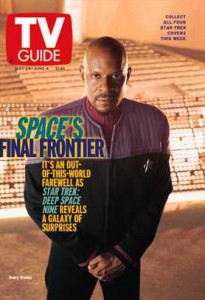
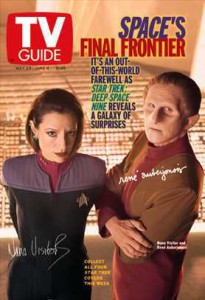
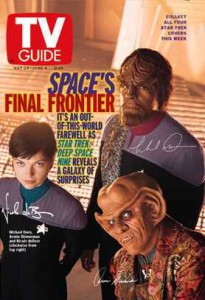
I was scanning the early Internet whenever I could for information on upcoming episodes or series’ developments, for stills from the set or for those tantalising episode trailers (usually in Quick Time format and with those tiny ratios). Being in the UK, we had to wait longer for the episodes than the US audience; it became a ritual that I would check for the release dates of the next DS9 VHS tape (two new episodes per tape) and I would go buy the new tape on that exact date, take it over to a friend’s house (I won’t name him, but certain You Tube users may know him as ‘Mumra 2k’) and we would watch the two new episodes and react to them.
From the beginning of the fifth season onwards, that was how we watched DS9; we couldn’t be patient enough to wait for the BBC to broadcast a new season, so we watched a new season like that – 2 episodes a month on purchased VHS release.
This somewhat aided the excitement; the tangible paraphernalia of the video tape and its artwork, the intriguing episode titles and their teasing synopses. The effect of this was strongest through the sixth and seventh seasons, where the more epic-style storytelling was reaching its zenith and the end was approaching.
Looking retrospectively, although the final two seasons were the most exciting, it was the fifth that was the most solid, consistent level of quality. Though actually if it wasn’t for the fourth season, I’m not sure I would’ve gotten so into DS9 anyway, evolving from a casual viewer into a proper, devoted adherent.
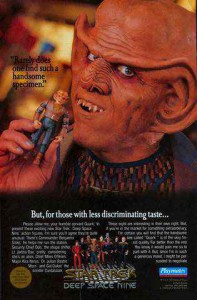
Though the first three seasons had some very strong moments (Duet, Necessary Evil, The Maquis, for example), the series hadn’t found its identity or its quality level and was still very much suffering from that “middle-child” syndrome that the show’s chief steersman Ira Behr often talked about in regard to the show airing in the shadow of the hugely popular Star Trek: The Next Generation.
In fact DS9 is the only Star Trek series that never got to stand alone on television; TNG, Voyager and Enterprise all had long spells as the sole Trek flagship on the small-screen, whereas TNG was still on the air for DS9‘s first two seasons and Voyager kicked off once TNG ended.
This might’ve put DS9 in an extra difficult position when it came to holding and retaining both audience and media attention.
My own interest for the first three years wavered, though there were occasional signs of the future brilliance that was to come; season three’s Improbable Cause and The Die is Cast, for example, offered compelling indications of DS9‘s future quality level, even if the broader season of shows was an extremely hit-or-miss business.
For me it wasn’t until Season Four (and a significant level of re-tooling) that DS9 truly announced itself; and Season Five where it truly found its quality level. While the arrival of TNG‘s Worf and the heavier incorporation of the Klingons into the already-rich tapestry helped create new hype and also to bring in more of the TNG audience, a new-look, badder-ass Captain Sisko and a subtle improvement in overall costume design also created a better dynamic.
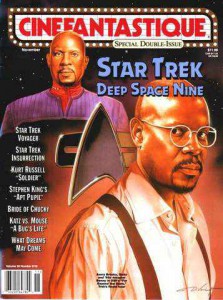
By the time Season Five arrived, DS9 had hit a level that TNG had only occasionally attained and that Voyager would never in its full seven seasons even get anywhere near.
The final three seasons of DS9 are as good as Star Trek is ever likely to get.
In fact, television itself rarely gets as good as that. There are four main factors that put DS9 on a pedestal rarely reached by other series’; high quality storytelling by a roster of talented writers, a very high standard of production value, special effects and set design, frankly brilliant scripting, and, most of all, a superb array of characters and of extremely talented performers portraying them over an extended period of time.
IT’S THE CHARACTERS…
To my mind a more endearing and engaging ensemble has never been assembled for a television series, and most of them portrayed by first-class actors. For one thing, I’ve yet to see an American TV actress play a role as beautifully as the criminally-underrated Nana Visitor did over seven years in the form of Kira Nerys, a character as far away from fictional female archetypes as you could get; a terrorist full of hate and anger who, across the series, matures into a responsible leader as well as a moral and compassionate heroine.
I’d be intrigued if you could cite a television series that could boast so rich a collection of well-developed characters as DS9 does; everyone from the avaricious Quark and the cantankerous one-of-a-kind outcast Odo, to the beautiful Jadzia Dax (a woman who is the eighth incarnation of the same soul, so to speak) and the prim and proper Doctor Bashir (played by Alexander Siddig, who also makes a good job of portraying brooding Arabs in films), who starts out an idealistic and clean-as-a-whistle medical student and ends up a grim-faced, war-ravaged pragmatist mired in secret plots and conspiracies.

There’s the brilliant Garak, who is a tailor by day and a secret spy working for the space-Nazis (otherwise called Cardassians) by night. The compelling Damar, who starts off a villain in charge of an evil empire and ends up a freedom fighter and dies a hero. The twisted and complex Gul Dukat; a spellbinding exercise in the psychology of dictators, the character boasting all the complexity of a Caligula but with the charm and swagger of a Mark Antony. The charismatic Weyoun, who is sort of a hypnotic version of Tony Blair, but who works for the allegorical Nazis. The religious leader, Kai Winn, who might be viewed as a sort of cross between a Margaret Thatcher type and a particularly Machiavellian Pope.
There’s more; we have a character who’s basically a holographic continuation of Frank Sinatra, for example (‘Vic Fontaine‘, played by the sixties TV star James Darren), or the lovable Miles O’Brien, portrayed by well-known Irish actor Colm Meaney. And our main character, Benjamin Sisko (played with great dignity and charisma by Avery Brooks); an African-American who, it turns out, is a religious icon to an entire race (a kind of space-Moses), who has been created by gods (or scientifically-explainable super-entities) who live in a wormhole.
The performance level of the actors was generally superb, with cast members like Nana Visitor and Rene Auberjonios being more than a match for the likes of Patrick Stewart and Brent Spiner in The Next Generation; adroit character actors like Armin Shimmerman (Quark), Marc Alaimo and Casey Biggs (Dukat and Damar), Jeffrey Combs and Andrew Robinson (Weyoun and Garak), and Wallace Shawn (a primarily comic-relief character, Grand Nagus Zek), to name just a handful, created entities that were in equal measure compelling and endearing, and so full of personality and life as to be permanently embedded into the loyal viewer’s mindscape for life.
All of that and I almost forgot to even mention Rom and Aron Eisenberg’s lovable Nog; or the Klingon General Martok! The series also drew guest appearances from the likes of Iggy Pop, amongst others.
EXTRAORDINARY STORIES AND MOMENTS…
Across its seven years (particularly the latter three) DS9 created so many extraordinary stories and moments that it’s difficult to even pick out the best; but it’s the diversity of the storytelling that’s most extraordinary, flowing seamlessly from dark and compelling (In the Pale Moonlight or Strange Bedfellows, for example) to light-hearted and comedic (You Are Cordially Invited, Take Me Out to the Holosuite), from epic galaxy-spanning plots (Sacrifice of Angels, The Changing Face of Evil) to simple, character-focused drama of the best possible kind (Chimera, Doctor Bashir, I Presume), and high-concept science-fiction (the brilliant Children of Time, for example).
–
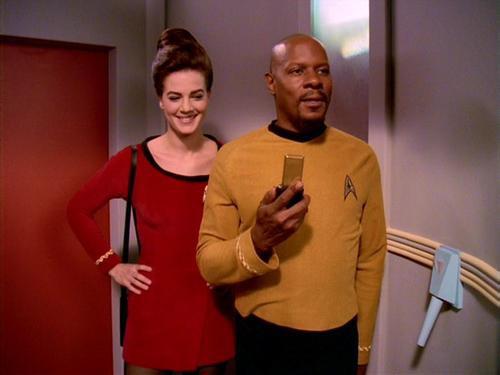
The writing and performances could reach levels of poignancy that a great many more ‘straight’ dramas could only dream of; as it does in, for example, the episode Chimera, which is a powerful examination of what it means to be a loner in a society, the subject of mistrust or racism in turn becoming mistrustful and racist in response.
Or the relatively early episode Duet, which deals with issues of guilt, conscience and forgiveness in regard to the uncomfortable subject of war crimes.
Meanwhile some of the ideas leave other SF television series grasping at thin air. An episode named Far Beyond the Stars, for example, is set in the 1950’s and portrays a black SF writer of that time, the gist of it being the possibility that the entire television series we’ve been watching is being imagined in the mind of a black writer in the fifties who created this idealized fantasy future as an escape from the racial persecution he is experiencing in his bleak life.
In the fifth season Trials and Tribble-ations (then) state-of-the-art effects allowed an episode of the original Star Trek series from the nineteen-sixties to be blended seamlessly with the DS9 cast, allowing, for example, DS9‘s main hero Benjamin Sisko to do a scene with a thirty-something-year-old William Shatner.
Far Beyond the Stars and Trials and Tribble-ations are two stories that couldn’t be further away from each other in tone, but both are television masterclasses that perfectly exhibit the kind of diverse levels of excellence DS9 aspired to.
Elsewhere, DS9 could do flawless film noire (Season Two’s Necessary Evil) or pitch-perfect comedy (Take Me Out to the Holosuite, In the Cards, etc), while doing character studies as psychologically unsettling as Waltz (a study of madman, Dukat).
WAR, RELIGION TERRORISM, EXTREMISM, AND THE THEMES OF DS9…
The themes the series deals with; war, racial persecutions, terrorism, coups, totalitarian regimes, secret organisations, interstellar espionage, religious extremism, quantum physics, inter-racial marriage… the list goes on and on. All of that and of course the obvious mix of high-concept science, action-packed adventuring, brilliant special effects and set pieces (particularly in the marvelous Sacrifice of Angels, which contains the most breathtaking visual effects I’ve ever seen for a television production), complex relationships and of course poignant love stories and even more poignant stories of platonic love.
Two of the recurring central themes in DS9 are highly challenging ones; firstly, exploring the point where science and religion meet and make reality (where do ‘gods’ become scientifically explainable phenomena, for example), and secondly a constant exploration of morality and often the turning of morality on its head.
The good guys often do very questionable things (In the Pale Moonlight, for example) and the bad guys often gain our sympathy through being well-developed, three-dimensional characters and not textbook villains.
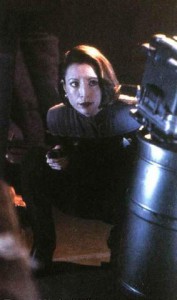
Dramatic ironies are also the lifeblood of the series, the long-term development of characters being full of them; there is a constant poetry to the way stories are developed and resolved and to the journeys that the characters take.
The way almost every character on the show was given a palpable character arc across even seasons is something no other Trek series has done: and very few TV shows of any kind do. You can clearly trace the path of various characters across seven years in a beautiful way: Kira’s path from angry terrorist to responsible leader, Sisko’s path from reluctant presence to outright hero, Bashir’s path from annoying, motor-mouthed know-it-all and wide-eyed optimist to sullen, restrained pessimist, Nog’s path from juvenile delinquent to accomplished officer, Damar’s path from brutish villain to selfless hero, etc: the list goes on.
What it shows is how much those writers cared about these characters and wanted them to each have their own path/story within the broader tapestry of the overall story of the series.
I watched an absolutely brilliant documentary series on Channel 4 (UK) two years ago called Apocalypse: The Story of the Second World War, which charted the timeline of World War II from beginning to end; when watching this I noticed how much the storyline and tone of DS9 echoed the real-world events of WW2 and that maybe this was a central part of its appeal.
The bulk of DS9‘s bigger storylines and episodes could be seen as a sort of futuristic World War II allegory, in fact (the galaxy-spanning war that forms the main overarching storyline for the final two seasons of the series involves every major race or power in the Star Trek universe).
BEFORE THIS TURNS INTO AN ESSAY…
I could go on and on, but I think I’ve said enough; besides, there aren’t enough superlatives in the dictionary. There are two dozen more things I want to say about the show, but it’d turn this into an essay.
DS9 is without doubt the best of the Star Trek series’; even if it isn’t the most popular or the most talked about.
It may, in time, gain more popularity; but it doesn’t matter if it doesn’t. Old Walt Disney productions Pinnochio, Dumbo and the The Jungle Book were all flops at the box office, but all are now rightly considered masterpieces. Frank Capra’s It’s a Wonderful Life, now considered an all-time classic, bombed when it came out in the forties. Likewise The Shawshank Redemption was a commercial failure at the time of its release.
And no one gave a flying fig about Vincent Van Gogh until he was dead.
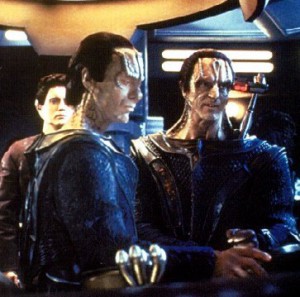
However, DS9 has gained, if not necessarily more popularity, then certainly even more resonance in the decade since its end. In our post-9/11 world, the themes and struggles of the series have in fact become even more relevant.
Here’s a mainstream (at the time) US television series that has terrorists as hero and heroine figures (Kira Nerys, Michael Eddingtion and the Maquis, and in the end the likes of Damar and Garak), that justified terrorism frequently, and that also dealt massively with dictators, civil uprisings, occupations of foreign lands, long-term peacekeeping forces, alliances with corrupt regimes, immoral behavior by government agencies (Section 31 and the CIA, anyone?), and the like.
If DS9 were on the air right now, in this current global climate that’s witnessed the rise of global terrorism, real-world wars and bloody uprisings (Libya, Syria, Egypt, for example), ultra-violent conflicts and flashpoints (Syria, Ukraine, for example), religious turmoil, corrupt government schemes and agencies (CIA revelations, for example) and a permanent war economy (the perpetual ‘War on Terror‘), among other things, then the series would be regarded as having its finger on the pulse of global events and as being a commentary on 21st century Geo-political affairs.
And it did this in an extraordinarily non-biased way. In dealing with the fifty year military occupation and rape of an entire world and society (Bajor) by a foreign colonial power with racial supremacy overtones, the show nevertheless took care to show the cruelty on both sides: the ‘terrorists’ or resistance fighters could be just as brutal or morally questionable. In the two-parter The Maquis, we saw a terrorist organisation being created before our eyes: but one that had very legitimate reasons for its actions, based on political injustices and unfair border delineations, etc: all very, very real world concerns, entirely relevant to contemporary geo-political crises.

Yet it ended over a decade ago (two years before 9/11) and followed on from a much more optimistic and idealistic tone that underpinned its predecessor Star Trek: The Next Generation.
It’s possible, on the other hand, that some of these themes, especially the lionising of certain terrorist characters and resistance movements in the series, may have rendered the series unpalatable to some audiences even retrospectively, especially in America. If it were being written now, it is unlikely that characters like Kira Nerys, Damar or Michael Eddington, for example, would’ve been written the way they were.
I also believe that the fact that the series’ main character is black may have something to do with the show’s glass ceiling as far as mainstream crossover is concerned, though perhaps I am being too cynical there.
On the matter of social or political commentary, we should also note that the show frequently explored (or made satire of) the very idea of capitalism and financial systems: primarily via Quark and the Ferengi, who are used as the vehicle for exploring the more extreme end of contemporary capitalist ideologies (but usually in a humorous way).
Either way, Star Trek: Deep Space Nine is a series that continues to grow in legacy, even a decade-plus after its end.
For me personally, it remains one of my two or three absolute favorite TV shows of all time and it always will; I might live to my eighties and still be re watching DS9 on an annual basis and still loving it just the same. All it takes is a fleeting shot of Quark’s Bar, Odo’s stiff, policeman-like walk, Damar’s proud sneer, Jadzia’s batting eyelashes or Sisko’s baseball and I feel like I’m arriving back home.
For loyal devotees of the series: and even many of those who’ve discovered it in the years since, DS9 will always inhabit a special place in our lives.
As Captain Sisko himself says in the series finale: “No matter where we are, no matter how far we travel, a part of us… a very important part… will always remain here… on Deep Space Nine.“



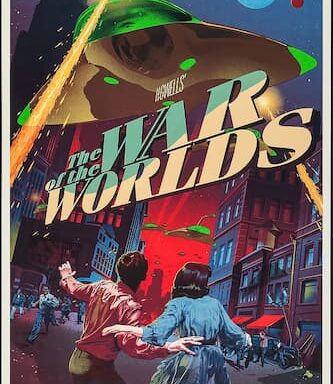

Such beautiful article, I shared it as well via twitter. It is just amazing experience when you explained how you used to watch DS9 when it aired, it sure brings a lot of memories to you! 😉
Thanks Rinda! I still completely am in love with DS9 – probably my favorite ever tv show. I’m really glad too that there’s a blog like yours out here to keep the DS9 talk alive.
BTW, if you ever want a guest-blogger for your blog, you know where to come!
DS9 is my favorite Star Trek show as well. My daughter and I went through TNG on DVDs and she loved them but I kept on saying, “You think this is good? Wait until we watch all of DS9 next!” So far we’re about midway through the 2nd season. What really sets DS9 apart from TNG in my opinion is that the early seasons were great (unlike a lot of TNG, I hate to admit) and the show continuously just gets better through all 7 seasons. The only bit I ever really didn’t like was Terry Farrell’s departure but luckily being a joined trill they had a way to work around that I guess with Ezri.
Thanks for your comment. I think I will love DS9 for the rest of my life, well into my old age 🙂 I agree with you about Terry Farrell; I liked Nicole de Boer/Ezri, but I think the series would’ve benefited from Jadzia remaining in it for the final season. For me, Season 5 was when DS9 left all other Trek series’ behind in terms of quality-level – from Season 5 onwards it was untouchable. I’m glad to hear anyway that you and your daughter have enjoyed the experience together.
I so enjoyed this article! And I agree that DS9 is sadly underrated and under appreciated. During the time of its original run on television, I was busy helping my mom take care of my ailing father and so I saw none of the episodes. I’ve only begun watching (binge-watching) DS9 on startrek.com and Netflix just in the last two months. I’m already at the end of season five. I love this Trek! I used to think Voyager was my favorite, but DS9 trumps Voyager and all the other Treks.
I was trying to think who my favorite DS9 character is, and I just couldn’t choose. I love all of them, even Quark! But if I had to choose one or two, I think I would have to say Nerys because of her loyalty to the people she holds dear, and also Odo, because I can understand the solitary nature of his character.
In my office I have three pictures on the wall that my brother gave to me, just because he knows I’m a Trekkie. Every day I say good morning to Will Riker and two of my DS9 people, Benjamin Sisko and Kira Nerys. I love my office!
Thank you for this article. It’s so nice that you have shared your love of DS9 with all of us, and it’s a pleasure for me to be able to share my love of it with others as well.
Thanks Linda, for your lovely comments 🙂
It’s great that even though you didn’t catch the show when it was on the air (for very good reasons), you’ve taken the time to catch up with it even years later. Well worth it, isn’t it? And I’m glad you’ve saved yourself from being one of those people who still think Voyager was a better series – I despair of those people!
Anyway thanks for your comment and thanks for reading. And your office sounds awesome.
And thank you for your reply, Burning Blogger. Yes, catching up on DS9 is definitely worth it. As soon as I finish one episode, I’m eagerly looking forward to the next one.
Live long and prosper!
Amen. Underrated show.
Thank you for this lovely article. I’ve recently started showing this to my friend for the first time, and re-watching has reminded me why I love it so much. This covers so many of my own feelings about the show so thank you for sharing them.